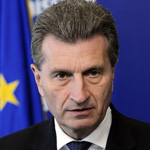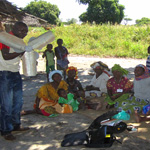 It was a tough year. The financial and debt crisis lurked in Europe and the US throughout 2011 and even fast-growing economies in Asia began to stutter. The international community still did not come up with a legally-binding agreement on limiting and then rapidly reducing toxic greenhouse gas emissions. Unemployment was high, social unrest leapt from country to country. And yet, despite all that despair and uncertainty, wind power remained a beacon of good, proving to weary politicians that the emissions-free technology can deliver on jobs, electricity supply, and the environment. The EWEA Blog covered developments;
It was a tough year. The financial and debt crisis lurked in Europe and the US throughout 2011 and even fast-growing economies in Asia began to stutter. The international community still did not come up with a legally-binding agreement on limiting and then rapidly reducing toxic greenhouse gas emissions. Unemployment was high, social unrest leapt from country to country. And yet, despite all that despair and uncertainty, wind power remained a beacon of good, proving to weary politicians that the emissions-free technology can deliver on jobs, electricity supply, and the environment. The EWEA Blog covered developments;
Another look at EWEA’s Breath of Fresh Air Blog in 2011
Building a wind turbine in less than seven minutes is no easy task
One of the most uplifting wind-power-related videos I’ve seen this year was one shot in Massachusetts that recorded a 1.5 MW onshore turbine being assembled.
Everyone knows assembling a wind turbine is an extremely challenging job. The various components, many of which are huge in size, have to be brought to a site where a foundation has already been prepared with a lot of steel and concrete. The assembly process can involve boats, trucks and an assortment of cranes with different rigging mechanisms. A fence or a safety perimeter has to be established and special attention is paid to overhead cables. After the checklist is reviewed one last time, and the installers are given a final briefing, the assembly finally begins.
It’s a laborious job with special attention paid to the slightest detail. But at the Massachusetts Water Resources Authority’s DeLauri Sewer Pump Station in Charlestown, a turbine was recently assembled in, wait for it, less than seven minutes.
That’s right, in less than seven minutes. Through the wonders of time lapse photography captured by Jay Groccia of OnSite Studios, you can also marvel at the site of installers erecting the 1.5 MW turbine — a relatively small machine compared to the 3 MW turbines which are becoming the norm these days in Europe — that is expected to generate 3 million kilowatt hours of electricity per year and save MWRA ratepayers €270,000 annually.
You can join in the fun by watching this amazing spectacle, complete with an energetic soundtrack, above or on YouTube.
2030 targets for renewable energy by 2014
 It has been hotly debated for months, and last week – finally – the European Commission published its 2050 energy roadmap outlining several different scenarios for Europe’s energy future over the coming decades.
It has been hotly debated for months, and last week – finally – the European Commission published its 2050 energy roadmap outlining several different scenarios for Europe’s energy future over the coming decades.
For wind energy and other renewables the week was tense. Until now, the European renewables industry has been driven forward by renewable energy and carbon cutting 2020 targets. Investors in the sector need political commitments to renewable energy that extend to 2030 to help them make the right investment choices now.
Gas is reason for energy price rises
 In the UK renewable energies have frequently been blamed in the media for pushing up the cost of energy paid by the average UK household. But a new government report by the UK Committee on Climate Change looks set to lay that myth to rest – the report states clearly that gas is behind the price hikes.
In the UK renewable energies have frequently been blamed in the media for pushing up the cost of energy paid by the average UK household. But a new government report by the UK Committee on Climate Change looks set to lay that myth to rest – the report states clearly that gas is behind the price hikes.
The average UK household has seen the annual energy bill rise from £604 in 2004 to £1,060 in 2010 – a £455 increase. And nearly two-thirds (64%) of that increase was down to rises in the wholesale gas price while just 6.5% is due to subsidies for renewable energy, the report says.
Bringing wind power to some of Africa’s poorest people
 In Mozambique, nine people in ten have no access to electricity. Yet the village of Mipandi now has electric light for the first time thanks a wind-based micro-grid blue-print set up by EWEA’s chosen charity, Renewable World with local partners, The Clean Energy Initiative (TCEI).
In Mozambique, nine people in ten have no access to electricity. Yet the village of Mipandi now has electric light for the first time thanks a wind-based micro-grid blue-print set up by EWEA’s chosen charity, Renewable World with local partners, The Clean Energy Initiative (TCEI).
“In Mozambique, the expansion of clean and sustainable energy – such as micro wind power – offer clear advantages in addressing climate change and energy poverty”, says Jason Morenikeji from TCEI. He adds that Mozambique has 2,800km of coast-line, many inland lakes and highland which contribute to its localised wind patterns.







 Comments
Comments